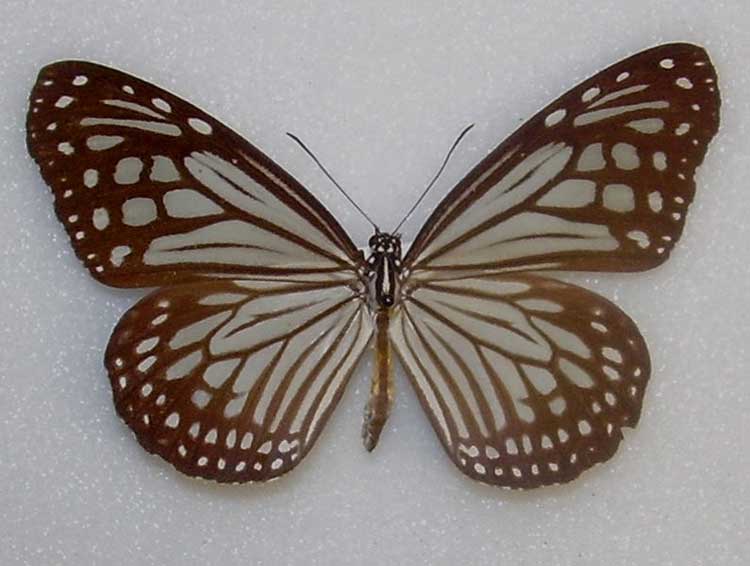
Parantica aglea (*)
Superregnum: Eukaryota
Cladus: Unikonta
Cladus: Opisthokonta
Cladus: Holozoa
Regnum: Animalia
Subregnum: Eumetazoa
Cladus: Bilateria
Cladus: Nephrozoa
Cladus: Protostomia
Cladus: Ecdysozoa
Cladus: Panarthropoda
Phylum: Arthropoda
Subphylum: Hexapoda
Classis: Insecta
Cladus: Dicondylia
Subclassis: Pterygota
Cladus: Metapterygota
Infraclassis: Neoptera
Cladus: Eumetabola
Cladus: Endopterygota
Superordo: Panorpida
Cladus: Amphiesmenoptera
Ordo: Lepidoptera
Subordo: Glossata
Cladus: Coelolepida
Cladus: Myoglossata
Cladus: Neolepidoptera
Infraordo: Heteroneura
Cladus: Eulepidoptera
Cladus: Ditrysia
Cladus: Apoditrysia
Cladus: Obtectomera
Superfamilia: Papilionoidea
Familia: Nymphalidae
Subfamilia: Danainae
Tribus: Danaini
Subtribus: Danaina
Genus: Parantica
Species: Parantica aglea
Subspecies: P. a. aglea – P. a. melanoides
Name
Parantica aglea (Stoll, 1782)
Vernacular names
English: Glassy Tiger
தமிழ்: கண்ணாடி வரியன்
Parantica aglea, the glassy tiger,[1][2] is a butterfly found in Indomalayan realm that belongs to the crows and tigers, that is, the danaid group of the brush-footed butterflies family.[1][2]
Description
Two subspecies are recognized but neither form is constant either in markings or in habitat. In the British Museum collection there are specimens of true Parantica aglea aglea from Myanmar, and others, inseparable from typical Parantica aglea melanoides, from Mysore.[3]
Subspecies Parantica aglea aglea
Ground colour fuliginous black with subhyaline bluish-white streaks and spots. Forewing: vein 11 anastomosed with vein 12.
Subspecies Parantica aglea aglea in Mhadei Wildlife Sanctuary
Upperside: forewing—interspace 1 with two comparatively long, broad streaks united at base, truncate exteriorly; cell with a very broad, somewhat clavate streak traversed by two fine black lines; basal spots in interspaces 2 and 3; an irregular discal series of three spots and two elongate streaks and a subterminal series of spots, the two series curved inwards opposite apex of wing, the latter continued along the apical half of the
costa; finally a terminal row in pairs in the interspaces, of much smaller spots. Hindwing: interspaces la, lb with broad long streaks from base; interspace 1 and cell with two streaks united at base in each, the pair in the cell with a short streak obliquely between their apices, an outwardly radiating series of broad, elongate, inwardly pointed spots in interspaces 2–8, followed by somewhat irregular rows of subterminal and terminal spots. Underside similar, the markings and spots sometimes a little ill-defined and blurred.[3]
Antennae black; head and thorax black spotted with white; abdomen blackish brown, ochraceous beneath. Male secondary sex-mark in form 2.[3][4]
Subspecies Parantica aglea melanoides
Subspecies Parantica aglea melanoides on Indian turnsole (Heliotropium indicum) at Jayanti in Buxa Tiger Reserve in Jalpaiguri district of West Bengal, India
Northern and eastern form. Differs as follows: Wings on the whole longer and narrower; hyaline markings, especially in interspace 1 of forewing and in cells of both forewing and hindwing, very much broader. In many specimens the black ground colour in these spaces is reduced to a mere slender black line enclosed in the subhyaline marking. On the underside the streaks are often much blurred and diffuse.[3]
Wingspan 70–100 mm.
Distribution
Subspecies Parantica aglea aglea: Sri Lanka, the Western Ghats north to Pune and the Niligiris. Subspecies Parantica aglea melanoides: the Himalayas from Kashmir to Nepal; Sylhet; Assam; Cachar; Chittagong; Arrakan; Burma and Tenasserim.[3]
Plate from Frederic Moore's The Lepidoptera of Ceylon depicting imago, larva and pupa
Life cycle
Food plant
Tylophora carnosa.
Tylophora pauciflora
Eggs
White pearl-shaped eggs are laid under the leaves .They hatch after about three days.
Larva
Dark claret brown, two round chrome-yellow spots on each segment, with scattered smaller bluish-white spots between, clustering into and forming a conspicuous line along the sides; legs and ventral surface purplish black, the tentacula, placed as usual on the 3rd and 12th segments, claret brown.[3]
Pupa
Green, spotted with silver , black and gold; much constricted behind the thorax.[3]Range
Western Ghats, north-east India , Sri Lanka and Malay peninsula.[3]
See also
Danainae
Nymphalidae
List of butterflies of India
List of butterflies of India (Nymphalidae)
References
Varshney, R.K.; Smetacek, Peter (2015). A Synoptic Catalogue of the Butterflies of India. New Delhi: Butterfly Research Centre, Bhimtal & Indinov Publishing. p. 150. doi:10.13140/RG.2.1.3966.2164. ISBN 978-81-929826-4-9.
Savela, Markku. "Parantica aglea (Stoll, [1782])". Lepidoptera and Some Other Life Forms. Retrieved July 3, 2018.
Public Domain One or more of the preceding sentences incorporates text from this source, which is in the public domain: Bingham, Charles Thomas (1907). Fauna of British India. Butterflies Vol. 2. Taylor & Francis. pp. 18–19.
Public Domain One or more of the preceding sentences incorporates text from this source, which is in the public domain: Moore, Frederic (1890–1892). Lepidoptera Indica. Vol. I. London: Lovell Reeve and Co. pp. 55–57.
Retrieved from "http://en.wikipedia.org/"
All text is available under the terms of the GNU Free Documentation License

